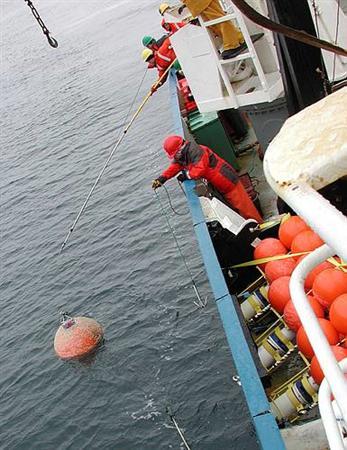Former Cold War Foes Team Up To Probe Warming Seas
Country: US/RUSSIA
Author: Jeffrey Jones

Crew prepare to snag a buoy marking the spot where
scientific data equipment has been sitting on the seabed off the
Siberian coast during the joint U.S.-Russian oceanographic in the
Bering Sea on board the ship Professor Khromov August 24, 2009.
Photo: Jeffrey Jones
ABOARD THE PROFESSOR KHROMOV - Rebecca Woodgate had no time for idle chat as her oceanography team scurried on the deck of their research ship during a recent mission in the Bering Strait, a crucial region for studying the impact of global warming.
Woodgate, of the University of Washington's Polar Science Center, had much to do in a short time, pinpointing undersea locations of eight data-gathering moorings on the U.S. and Russian sides of the strait, electronically coaxing them to the surface and sinking new ones that will be anchored for a year.
It's exacting work that must be done quickly for readings to be useful to her and her colleagues on a joint U.S.-Russian expedition to gauge the impact of climate change on the far north waters between the former Cold War foes.
When an onlooker wandered too close to the action during a deployment in choppy seas off the Siberian coast, the British-born scientist hastily handed him used packaging from a piece of gear and said, "Here -- do something with this."
Resembling strings of beach balls, the moorings provide precision measurements of currents, temperature and salt content. Some even record whale sounds for the mission, called RUSALCA, or Russian-American Long-term Census of the Arctic.
RUSALCA, which in Russian folklore is the name of a female water nymph, has uncovered growing evidence of warming and its effects where the Pacific and Arctic oceans meet.
Organized by the U.S. National Oceanic and Atmospheric Administration and Russian Academy of Sciences, it does so while balancing the objectives of two countries with growing interest in securing their resource-rich Arctic territories as open water make them more accessible.
The area is a crucial piece of the climate change puzzle.
"I see the Bering Strait as potentially a trigger for ice melt," Woodgate said, while uploading the moorings' data on the Russian research vessel Professor Khromov.
The need for complete information, from Alaska's coast to Russia's eastern tip, makes bilateral cooperation important. Without it, "You're toast," she said.
Woodgate was among about 50 scientists from the United States, Russia and other countries aboard the Khromov for six weeks in August and September, studying water and sea life in the Bering and Chukchi seas and Arctic waters well north of Wrangel Island off Russian's northeast coast.
RECEDING ICE
It's difficult to imagine when cold, gale-force winds and heavy seas buffet the ship in late summer that warmer and fresher water flowing through the strait into the Arctic may be pushing the sea ice edge back.
In 2007, it retreated a record amount, startling scientists. This summer, the ice receded to its third-smallest area in recorded history, according to the U.S. National Snow and Ice Data Center.
It is a vicious cycle, scientists say. Once the ice shrinks, open water absorbs more of the sun's heat, melting more ice.
"There is no debate that the atmosphere is getting warmer, and perhaps the Arctic the most," said Aleksey Ostrovskiy, one of the mission's Russian coordinators and a former diplomat. "That is why scientists have chosen this area for their research, because it indicates the change very well."
It was tough convincing Russia's defense ministry and other authorities that allowing U.S. scientists and their equipment into the country's waters would not compromise national security, he said. Their movements are monitored closely.
Since the maiden RUSALCA voyage in 2004, researchers have identified species of fish and other organisms such as crabs that had never previously been able to survive this far north.
"It is a very interesting question about what happens out there where the ice has normally been all the time and now is retreating," said Terry Whitledge of the University of Alaska Fairbanks, RUSALCA's science chief and one of oceanography's elder statesmen with nearly 90 cruises under his belt.
Still, retreating ice spells opportunity for the mission.
This summer, ice maps showed the Khromov may be able to travel further north in the Arctic than in previous cruises, allowing more detailed research before the scientists return to Nome, Alaska, in late September.
As countries prepare to meet in Copenhagen in December to hammer out a deal on carbon dioxide emissions, scientists aboard the Khromov said limiting the gases most often blamed for global warming will help to better predict what changes are happening and how to adapt to them.
Kevin Wood, whose scientific specialty is compiling and analyzing climate data going back hundreds of years, said all evidence points to a warming earth.
"The other part of that argument is: Is it CO2 or is it natural variability? How much does each contribute to the trend? Is there anything we can do about it?," said Wood, who is also a veteran mariner.
"My view is, well, CO2 is going through the roof. We know it's going to have an effect, and whether it's one degree or eight degrees, it's going to be something and it makes sense to try and put a curb on it."
(Editing by Alan Elsner)
© Thomson Reuters 2009 All rights reserved
